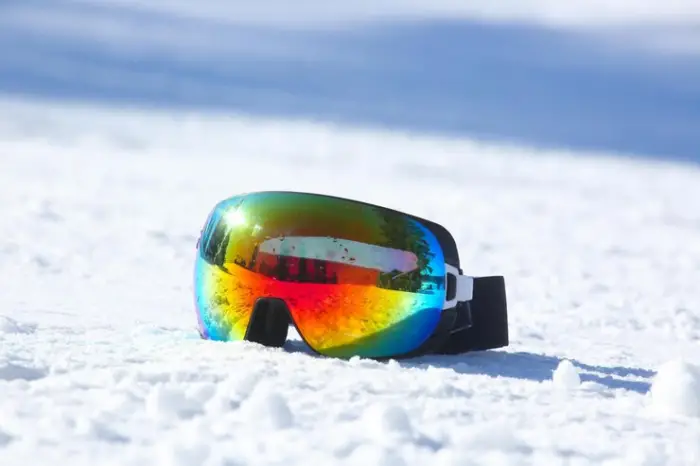I see that you’re looking up the features of ski goggles. You’re planning to buy one, am I right?
Well then, don’t you think you should know everything about the item you want to buy before you proceed to buy them? Hah!
You’re at the best place to know everything regarding polarized and non-polarized ski goggles! Scroll down and read till the end.
Polarized Ski Goggles
Polarized ski goggles are eyewear designed with lenses containing a polarizing filter. This unique feature effectively reduces glare caused by sunlight reflected from snow, ice, and other flat surfaces, enhancing visibility and clarity on the slopes. The polarized filter blocks light waves that are responsible for most glare, providing improved contrast and enabling easier distinction of contours and obstacles.
These goggles also have essential UV protection. With reduced glare and eye strain, polarized ski goggles offer comfort and improved performance during extended periods of skiing or snowboarding in various light conditions. Because of these eye-catching reasons, polarized goggles are indeed one of the most demanded goggles in the market today!
Non-Polarized Ski Goggles
Non-polarized ski goggles are standard eyewear designed for skiing, snowboarding, and snowmobiling. They are a good choice for winter sports, but they lack the polarizing filter found in polarized goggles. And that is basically the reason why non-polarized lenses do not offer the same level of glare reduction. It does provide basic UV protection and some glare reduction, but they are not as effective in minimizing intense glare.
Since they lack the polarized nature, non-polarized ski goggles come in various lens colors to offer adaptability to different light conditions. They are a practical and budget-friendly option for skiers who seek normal amounts of eye protection and visibility on the slopes.
Difference Between The Polarized And The Non-Polarized Ski Goggles

We already know that one is polarized and the other one is not, but is it just the names that make them different? Let’s find out! Here’s a clear differentiation between polarized and non-polarized ski goggles:
Glare Reduction
Polarized goggles have a polarizing filter that reduces glare caused by sunlight reflecting from snow and other flat surfaces. This enhances visibility and improves contrast, particularly in bright conditions. On the other hand, non-polarized goggles offer very basic glare reduction. But they may not be as effective as polarized goggles. The glare reducing feature of the polarized goggles is at a different level!
UV Protection
Both non-polarized and polarized lenses offer amazing UV protection, and protects your eyes from harmful UVA and UVB rays.
Eye Strain Reduction
By minimizing glare, polarized ski goggles help reduce eye strain and fatigue during extended periods of skiing or snowboarding. The non-polarized lenses might not be able to provide you relief from eye straining in high altitudes.
Bright Conditions
Polarized goggles are particularly effective in sunny and bright conditions where intense glare is a concern.
Adaptability
Non-polarized goggles come in various lens colors, providing adaptability to different light conditions, including overcast and low-light situations. The polarized goggles, on the other hand, aren’t as versatile as the non-polarized ones.
Budget-Friendly
You won’t have to break the bank while buying non-polarized goggles because it’s generally very affordable. But when it comes to polarized goggles, a little pressure on the wallet is needed.
Which One Should You Buy? The Polarized One, Or The Non-Polarized One?

Non-polarized ski goggles are a suitable choice for skiers and snowboarders who are active in rainy or low-light conditions. In simple words, where the use of glare reducing features aren’t very much needed. If you often ski on cloudy days or in areas with limited direct sunlight, non-polarized goggles can provide sufficient glare reduction. And, if you’re a budget-conscious individual who’s trying to save up for buying a car or a house while continuing to pursue your hobby of skiing, you can definitely opt for non-polarized goggles. Why sacrifice your hobby to save money, when you can just buy non-polarized goggles!?
Polarized ski goggles are an excellent investment for skiers and snowboarders who ski in bright and sunny conditions on the slopes. Zero doubts on this matter. The specialized polarizing filter effectively reduces intense glare caused by sunlight’s reflection from snow, ensuring better visibility and contrast. Skiers who prioritize performance should resort to the polarized goggles because, despite the fact that they’re going to be a pocket pinch for you, they’ll be providing excellent performance and will be a catalyst in improving your performance too!
Conclusion
In conclusion, both polarized and non-polarized ski goggles have their unique features and you cannot deny them! These make them effective options for different skiing conditions. Consider the features that you feel that you need the most for yourself and there you have it, your perfect pair!
It’s that easy!

